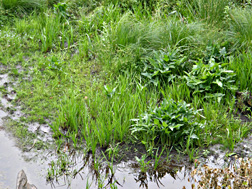Installing a Lawn Drainage System
Nature of the Problem
If you are starting a new lawn on ground that tends to be water logged, or if your existing lawn tends to retain surface water after heavy rain, then you will need to install some drainage.
Since water naturally runs downhill, you need to install the system so that the water runs to the lowest point of the lawn and where it can escape into a drain, a ditch or a soak-away.
Work out a plan for the drainage channels that covers the whole area where water collects. If this is drawn to scale it will help you to estimate the materials you need to buy.
It is normal to create the channels in a herringbone formation, with each of the branches draining into the central column, which in turn flows to the outlet. The water normally needs to flow naturally, without any form of mechanical aid and therefore the pipes need to slope in the direction of flow. You should aim for an incline of around 1 in 100.
Where to Begin

Before starting to dig, it is worth marking out the layout of the drains on the surface. If you are draining an established lawn, this can best be done using sand as a marker. If you are preparing ground for a new lawn, then it may be easier to use a spray can of paint but don't over do it.
Start digging the central channel, which needs to be deepest so that the other channels will run into it. Start at a depth of around 12in to 18in, bearing in mind that it needs to slope in the direction of intended flow. Once you have completed digging this initial channel, it is worth testing it by pouring water in at the highest point and checking it runs down to the outlet.
You then need to lay some form of drainage pipes. These may take the form of 3in or 4in diameter clay pipes or you can purchase 3in perforated drainage pipe that is used in conjunction with a layer of clean stone.
The side drains may be constructed in a similar fashion to the main drain, bearing in mind that they need to be a little higher so that the water drains away easily. Alternatively, if the amount of water is not all that excessive it may be sufficient to dig out some narrow slit trenches that you then fill with sand before finishing off at the surface with a layer of turf or shallow layer of soil if planting seed.
View alternative methods for installing drainage
Before Completing the Work
Again it is worth checking that the drainage system works before backfilling the trenches with soil and turf.
As a final aid to help drainage, it is a good idea to give the lawn a regular dressing of washed sand so that it builds up around the grass roots to enable the water to drain away freely.
Read more about Lawns |
Read more about Plants |
